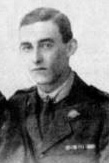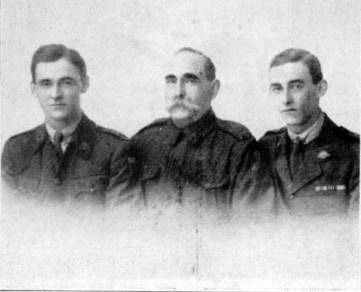William Alfred Leaver MC MM
From Our Contribution
 Australian Fighting Sons of the Empire p.204 | |
 Charles (Jnr), Charles (Snr), William Leaver | |
| Personal Information | |
|---|---|
| Date of Birth | Sep 1895 |
| Place of Birth | Cobar, New South Wales |
| Death | 25 Feb 1942 |
| Place of Death | Adelaide, South Australia |
| Age at Enlistment | 19 years |
| Occupation | Teacher |
| Religion | Church of England |
| Address | 62 Cargill street, Victoria Park, Western Australia |
| Next of Kin | Mother , Mrs Mabel Leaver |
| Military Information | |
| Reg Number | 467 |
| Date of Enlistment | 8 Mar 1915 |
| Rank | Lieutenant |
| Unit/Formation | 28th Battalion, C Company |
| Date of Embarkation | 29 Jun 1915 |
| Ship Embarked On | HMAT A11 Ascanius |
| Date of Return | 1919 |
| Ship Returned On | HMAT A30 Borda Served as paymaster during voyage |
| Fate |
WIA 1917 Returned to Australia |
| Monument |
Gosnells Road Board Honour Roll Victoria Park Honour Roll |
| Medals |
Military Cross Military Medal 1914-15 Star British War Medal Victory Medal |
Pre War
Educated in Adelaide before the family moved to Western Australia.
War Service
Enlisted in WA as a private and allocated to C Company of the 28th Battalion, then being raised in Perth. Sailed with them to Egypt in June 1915 and on to Gallipoli where he served for a short time until he suffered with a poisoned hand requiring his evacuation. While on Gallipoli he wrote home
"I am in the trenches doing my bit on the gun. We are not to fire unless attacked. The Turks have just given us a demonstration just to try and draw our fire, but were not successful. Things were lively for awhile. Shrapnel, rifle and machine gun fire played on our parapets for a good half hour and all we could do was to wait and watch with periscopes. But the excitement soon died down and everything is a s quiet as can be except for an occasional rifle shot"[1]
He appears to have been with the battalion when it was withdrawn from Gallipoli to Lemnos Island as one of his fellow soldiers in his letter home wrote:
:William Leaver and Walter Wilson went into the village and brought back some wine which only wetted our thirsts. By a clever scheme the three of us managed to get two jars of rum from the A.S.C. dump, although guarded by a sentry. With this, our tent had an excellent Christmas Eve. As planned the empty jars were dumped in the sea. Next morning, half the company went diving, thinking we had planted full ones."[2]
In October 1916 the 28th Battalion with the rest of the 1st Anzac Corps moved south to attack German positions west of Gueudecourt in atrocious weather. The ground had turned to slippery mud and the men attacking a salient known as the Maze on 5 Nov 1916, were unable to keep up with the protective barrage and came under heavy enemy fire, with most survivors taking cover in shell holes in no man's land. William in a letter said
"...I with about twelve men drop into a shell hole within thirty yards of the objective. No use going on - no men - two badly wounded men, four slightly, eight fit. Remained in hole all day sniping. Sent a corporal ( he was by this time a Sergeant) in at dusk to bring out two stretchers. Killed. After waiting, went myself and brought out two stretchers with two volunteer bearers. Got the wounded in with the help of two men whom I had left with them. Had two men shot dead while doing so."[3]
Later William was involved in organising the further rescue of wounded men from no man's land while under fire, earning him his Military Medal.
Following his award of the Military Medal William was commissioned 2nd Lieutenant on 27 Dec 1916. On 28 Feb 1917 William was leading a party of bombers who were successfully bombing heir way up Malt Trench near the Maze when he was seriously wounded by machine gun fire from a German strong point at the junction of Gamp and malt Trenches. Evacuation to England followed, but he was back with his unit, having been promoted to Lieutenant (on 27 May 1917) before the end of September, as he participated in the battle for Broodseinde Ridge near Ypres.
On 21 Oct 1917 he was presented with his Military Cross by Lt General Birdwood.. In January 1918 William marched out for England for duty with the Training Battalion. His return to Australia involved him serving as the Paymaster on HMAT A30 Borda in 1919.
Both his father 5363 Sapper Charles Henry Leaver, and his brother 5425 Private Charles Henry Leaver served in France and returned to Australia.
Award Comment
Military Medal
"During the attack on German positions north of Flers, on morning of 5th November, 1916, displayed great courage and endurance, both during and after the action. He displayed utter disregard for personal safety, going out after two enemy snipers who were causing casualties amongst our men, and accounted for them. This was done under heavy shell fire."[4]
Military Cross
"For conspicuous gallantry and devotion to duty. He organised a bombing attack at a critical time and succeeded in gaining a lot of the enemy's trench. he set a fine example to his men. He was subsequently wounded."[5]
Post War
During early 1924 in Moora, William married Eileen Agnes Flynn. A William J. Leaver died at the beginning of 1928 in Moora. Eileen died in Wembley Downs on 14 Dec 1986 aged 86.
Electoral Roll entries: 1921 at 66 Cargill street Victoria park - no occupation; 1925 Dalwallinu farmer; 1931 - 1934 North Dalwallinu, farmer; 1941 at 596 Magill road, Burnside, South Australia.
Notes
Best match for W Lever on Gosnells Road Board Honour Roll. Connection to Gosnells not yet proven, however, as a teacher he may well have taught in District. He is included on the Victoria Park Memorial.
William's full records are amalgamated with his service as SP6343 (Russia 1919?) and are therefore not on the Australian Archives site.